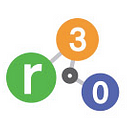From Liminal to Landed: r3.0 Shifts into Place-Sourced Resilience & Regeneration
By Bill Baue and Ralph Thurm
“When a system is far from equilibrium, small islands of coherence have the capacity to shift the entire system.”
Ilya Prigogine
2024 was a liminal year for r3.0, as we navigated across the threshold from a decade of pursuing a theory of transformation focused on economic entities (ie corporations and investors) as the most powerful levers of change, into a new place-sourced theory of transformation, with the bioregion and municipality as the locus of leverage. We first announced this transition at the beginning of the year; now, as the year winds down, we affirm our commitment to pursuing place-sourced resilience and regeneration. In this piece, we share in more detail the future trajectory of our journey, focusing in particular on our work in the bioregioning movement.
A few months ago, we framed our role in the bioregioning movement as curators of coherence in the context of collapse. In physics, coherence emerges when waves are in phase (or constructive in science-speak) — the combined waves multiply the amplitude beyond what the waves are capable of producing individually. Incoherence emerges, on the other hand, when waves are out of phase (or destructive in scientific lingo) — as you can see below, the wave amplitudes zero each other out.
This physics applies (metaphorically and literally) to social dynamics, including the practice of bioregioning: activation efforts can enable the emergence of constructive coherence when in phase, creating multitudes of amplification; or, efforts that are out of phase can cancel each other out in destructive incoherence [1].
As ecological and social systems careen toward catastrophic tipping points, incoherence increases in self-reinforcing feedback loops, exponentiating information quality degradation and confounding synergistic collaboration potential to the point of polarization. We at r3.0 counteract incoherence (and coax coherence) by 1) prioritizing ethical integrity and scientific rigor over political positionality; 2) rejecting competition in favor of collaboration; 3) embracing necessary transformation in the face of widespread incrementalism; and 4) centering prosocial relationality and cross-cultural solidarity, among other strategies.
The contemporary bioregioning movement emerged concurrently with the conceptualization and simultaneous actualization of overshoot and collapse [2] — namely, at the 1972 Stockholm Environment Summit that inspired Peter Berg and Judy Goldhaft to launch the Planet Drum Foundation, which helped galvanize the movement. Berg asserted coherence by healing the schism between nature and culture, grounding the bioregion as “a geographic terrain and a terrain of consciousness.”
We at r3.0 have long sought to curate coherence — and counteract incoherence — through two primary means: Convening, and Knowledge Commons Co-creation (bridged by the common denominator of Self-Governance). Each of these means are applicable to regenerative bioregioning, as we outline below.
1. Convening
“…congress is a verb. Congress, come together. Come together with the continent…”
Peter Berg, 1976
Convenings played a key role in galvanizing the early wave (1970s — 2000s) of the bioregioning movement, in particular through the Continental Bioregional Congress [3] format that gathered practitioners from geographically dispersed bioregions into an extended immersive experience that created cross-cultural coherence while also advancing hands-on self-governance through delegative policy development. As early as 1976, Berg asserted the need to Amble Towards Continent Congress, which bioregional reinhabitants did for the next eight years, building foundations for convening the first Continental Bioregional Congress (CBC) in 1984 on Turtle Island. The tenth (and last) CBC convened a decade-and-a-half ago…
The bioregioning movement is now ambling back toward Continental Bioregional Congressing. We at r3.0 see a role for us to play, by Confluencing (“flowing together”) toward Congressing. At the 11th r3.0 Conference this September, r3.0 Advocation Partner And Now What? prototyped the Confluencing model whereby primary events are complemented by distinct (geographic, temporal, scale, etc) events that weave together into a greater whole.
We will focus the 12th International r3.0 Conference on the bioregioning context (our theme this year: Catalyzing Bioregional Resilience & Regeneration: Learning to Reinhabit Earth Together) while also inviting bioregions globally to Confluence alongside our Conference, using its content as a launch pad for their own bioregional deliberations. To support this, we are developing a Confluencing template that bioregions can customize to their own contexts.
As well, we will devote our online Open Dialogue format to bioregioning, focusing our practice of hosting monthly public Zoom gatherings with featured speakers followed by facilitated discussion, on the co-creation and dissemination of bioregional knowledge. All our conveneings center relationality [4] to potentiate collective action, invite emotional authenticity, create space for generative tensions to energize conflict transformation, and nurture collapse resilience.
2. Knowledge Commons Co-Creation
“Every commons is based on natural resources. Every commons is a knowledge commons. Every commons depends on a social process [5].”
–David Bollier and Silke Helfrich, 2019
r3.0 focused our first decade on co-creating a knowledge commons of Blueprints co-created with Working Groups, as well as Common Good Resources and other materials. We now draw on this experience to initiate design of two-eyed bioregional knowledge commons (braiding Indigenous knowledge and Western knowledge), first focusing on the information architecture, drawing on diverse approaches (such the wiki — see examples here and here), formats (textual, video, audio, graphical, etc), and languages.
Knowledge informs action, underlining the vital importance of co-creating knowledge as an unenclosed commons to inform collective action for stewarding resources at the bioregional scale regeneratively, respecting the carrying capacities of these ecological and social capitals. Two key elements of knowledge commons curation include direct engagement with:
- knowledge stewards with their consent for sharing the knowledge respectfully; and
- practitioners applying the knowledge in on-the-ground bioregioning work.
“[Y]ou can only call it a knowledge commons,” Simon Grant points out, “if people are using the knowledge that they are curating, just as a genuine physical commons implies that people are using the shared resource. And, as Ostrom famously pointed out, a commons is only a commons if it is governed, and governed essentially by its users, not, for example, by a remote authority.”
As information architecture solidifies, we will start prototyping content that dynamically balances generalization with specificity. In other words, we will seek to encompass knowledge that’s broadly applicable and customizable across diverse bioregional contexts, while also including specific knowledge applications in specific contexts to provide illustrative detail. Bioregional knowledge we may cover includes: Bioregional Regenerative Economies and Cultures; Bioregional Learning Centers; Bioregional Funding Ecosystems / Bioregional Financing Facilities; Bioregional Carrying Capacity Measurement & Management; Bioregional Self-Governance; etc…
This last element illustrates the bi-directional aspect of knowledge commons, which both serve as a repository of information about bioregional self-governance, while also enacting the practice of self-governance of the knowledge commons by its users.
Municipality Engagement
Finally, nested within our bioregioning work is our work in the municipality context, which is anchored by a Partnership Engage Grant (PEG) from the Social Sciences & Humanities Research Council (SSHRC) of Canada, in collaboration with Randy Sa’d of our Advocation Partners, the Flourishing Enterprise Institute (FEI) and REFOCUS, and Daniela Senkl of the University of Guelph.
This applied research will explore the transformative potential of context-based sustainability (CBS) for municipalities, drawing on the experience of the City of Nanaimo that Ting Pan presented in the 2024 r3.0 Conference. Following this example, we will look at municipalities that have applied the Doughnut Economics and/or Sustainable Development Goals models (as Nanaimo did), and explore how the application of CBS enhances outcomes. For more information about this research project, see here.
In conclusion, while we won’t necessarily abandon our decade-long history of good-faith efforts to transform corporate and investment contexts to regenerative sustainability (see here & here for documentation of these efforts), we recognize that the systemic lock-ins of incrementalism and predatory delay present significant obstacles to success. Place-sourced work represents a much stronger attractor for collapse resilience and even the potential for flourishing. We look forward to some of you joining us on our landed journey.
Notes:
[1] We recognize the existence of other dynamics as well — such as the fact that destructive forces can also be “coherent” (ie in phase).
[2] The Limits to Growth (1972) conceptualized carrying capacity overshoot and consequent systemic collapse in 1972 (the phrase “overshoot and collapse” appears repeatedly in the book). Subsequent Ecological Footprint research in the 1990s confirmed that humanity actually entered Earth Overshoot (ie, depleting resources faster than they can be regenerated) on December 25, 1971. So humanity has been operating on phantom carrying capacity (“the illusory or the extremely precarious capacity of an environment to support a given life form or a given way of living” Catton, Overshoot, 1980) ever since.
[3] See here for a video of a dialogue on the history of Continental bioregional Congresses: https://vimeo.com/970582386
[4] We particularly frame our work around Melanie Goodchild’s notion of relational systems thinking. See here https://devondoughnut.org/ and here https://jabsc.org/index.php/jabsc/article/view/2027 for peer reviewed papers.
[5] David Bollier and Silke Helfrich, 2019, Free, Fair and Alive: The Insurgent Power of the Commons, New Society Publishers.





